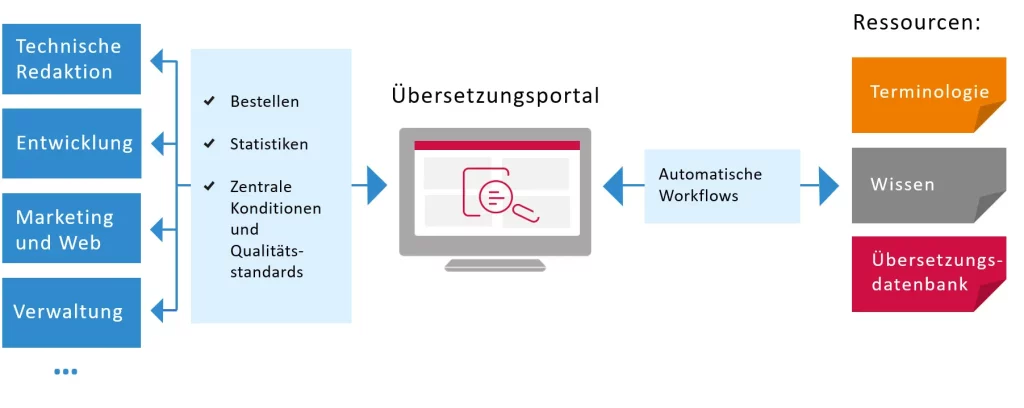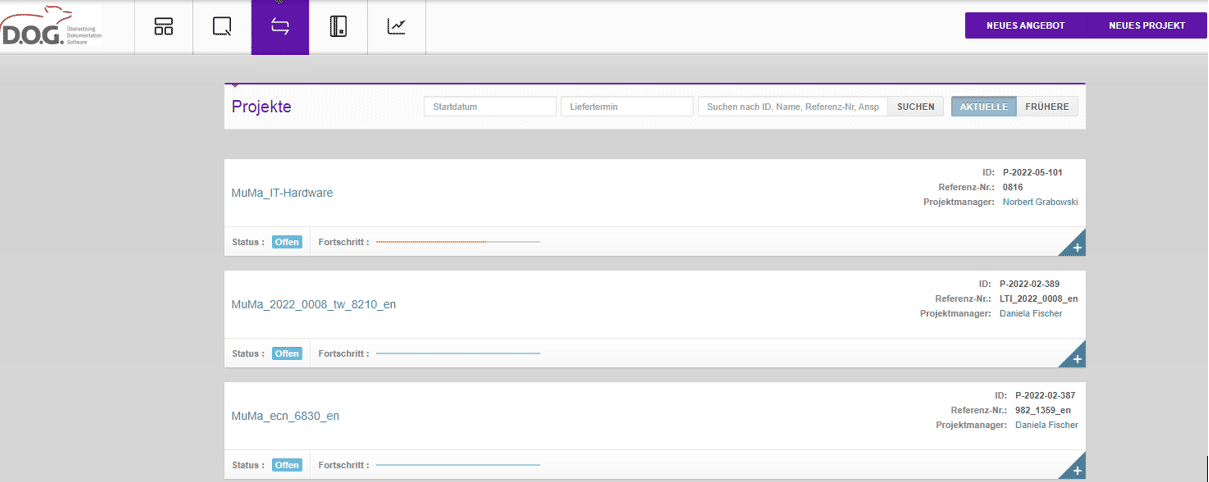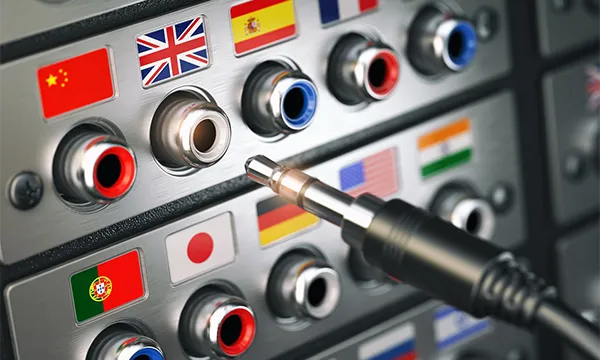
Convenient processing via customer portal
Customer portal for automated processes
- Standardized processing of your translation projects
- Comprehensive evaluations and statistics
- Automated workflows that save time and money
CUSTOMER PORTAL FOR YOUR TRANSLATION PROJECTS
Central processing of your translation needs via our customer portal
The customer portal is the most important interface between our customers and D.O.G. GmbH. Via the portal, customers can request quotations, place orders, find out about the status of their projects and much more.
Behind this is the complex and sophisticated production control system XTRF, which D.O.G. has been using for many years.

Translations by native speakers
We translate into all languages
Do you need a translation? We will send you a quote within the shortest possible time. Send us your request with this quote form.

Developments in the documentation industry
Much has changed in the communications, documentation and translation industry over the past 20 years. When EU enlargement had not yet taken place and documentation processes were still manageable, translation projects were easier to organize. The number of people involved in the documentation process was limited and many tasks were still done manually. The documents to be translated were sent to a few translators and quality checked at the end.
With the enlargement of the EU and the spread of new technologies for technical writers or translators, the situation changed quickly. Editing systems support the work of technical writers. Translation memory systems started to become popular in the early 1990s and are now used everywhere in the translation industry. As the number of people involved in the creation of information and translations increased, so did the need for terminology work and quality assurance mechanisms.
With EU enlargement, the number of languages needed also increased from the usual 3 to 4 languages (the so-called FIGS languages for French, Italian, German and Spanish) to the 24 official languages of the EU and often more (Asian languages were added, for example). The nature of individual projects also changed. Editorial systems / content management systems produced significantly more smaller files, some of which had only a few changes compared to previous versions of the content (topic: translation updates).
Manual project management is obsolete
This development and other factors mean that the traditional manual organization of translation projects is no longer up to date. It is very error-prone and the effort required for project management tends to increase. At the same time, the size of individual projects is decreasing, because often a lot of content is already stored in different databases (editing systems or translation memories).
It is no longer uncommon for projects to consist of 100 small XML files that are translated into 30 languages and have to go through 6 different production steps. Without a high degree of automation and extended software support, this can no longer be organized in a meaningful way.


Another SEO headline
Lorem ipsum dolor sit amet, consetetursadipscingelitr, sed diam nonumy eirmod tempor.

Another SEO headline
Loremipsumdolor sit amet, consetetur sadipscing elitr, sed diam nonumy eirmod tempor.

Another SEO headline
Lorem ipsum dolor sit amet, consetetursadipscingelitr, sed diam nonumy eirmod tempor.

Another SEO headline
Loremipsumdolor sit amet, consetetur sadipscing elitr, sed diam nonumy eirmod tempor.
Functions of the customer portal of D.O.G.
All our customers have the opportunity to work with us via our customer portal.
The customer portal provides a secure connection between our production system and our customers. The server is located in Germany, at our headquarters in Leonberg, near Stuttgart. The access is of course password protected.

Our customers can access various functions and views in the customer portal.
First, customers can request a quote via an integrated request form. As soon as the request has been sent with a mouse click, the responsible D.O.G. employee is informed immediately so that he can create the offer without losing any time.
When the offer is accepted, most of the data from the request is already in the XTRF project management software, such as the language combinations or the files to be translated. The quote can be immediately converted into a project by the responsible project manager and is automatically sent to the designated specialized translators.
The customer portal can also be used for communication. It lists the employees on both sides who are working together on translation projects. Our customers can send messages to project managers directly through the customer portal.
For ongoing projects, the current production status is always visible so that customers can check the current status of production, especially for important projects with tight deadlines.

The customer portal also has a history. It is possible to view previous projects at any time and, for example, download older invoices or re-download a translation at a later date (the retention periods for this are agreed individually).
The customer portal also offers a reporting function. It is possible, for example, to display the number of orders per period or per language combination. Reports on the total number of projects commissioned can be displayed, and much more. Different views can be configured individually. If you have special reporting requirements, we would be happy to discuss their implementation.

For more efficiency
The most important 7 functions of the D.O.G. customer portal at a glance
- 1. Automatic quote request
- 2. Placing translation orders
- 3. Upload or download project files
- 4. Automatic e-mail notifications about production steps
- 5. Extensive reporting and statistics
- 6. Invoice download
- 7. Download finished translations
Production automation with the workflow system of D.O.G.
Two translation management tools are widely used on the German market, Plunet and XTRF, both of which offer very comparable functions in terms of content. D.O.G. GmbH has been working with XTRF since 2013. XTRF supports D.O.G. GmbH’s translation management with a whole range of automations. These help to improve project quality and reduce project costs.
XTRF manages all resources centrally. We can see at any time which translators are available. We can select translators by subject area, language combination, translation technology or regular customer.
After a translation project is completed, our project managers and reviewers enter their experience with the respective translator into the system. This allows us to better assess what to consider when using that translator on future projects. For example, it may be that a specialized translator does an excellent job of translating technical documents, but for purely advertising copy he or she is a bit too literal. Or it may be that a translator cannot realistically estimate his or her working time and often requires more time than anticipated.
This way, we can ensure that we always find the optimal solution for your translation project and that there are no unforeseen surprises.
The digital order management system is constantly kept up to date. For example, when a translator uploads a finished translation, the system automatically detects this and initiates the next step, such as a revision. The person in charge of the revision is notified immediately and can start working. This means that no time is lost.
With our project management tool, we always have a complete overview of all ongoing projects, the current work status of individual projects, and can react immediately to specific developments if necessary. The data collected during projects is useful for project controlling and regularly enables small optimization steps that reduce costs in the long term.
.
Predefined workflows in the project management system of D.O.G.
We have defined standard workflows for typical processes. For example, a standard workflow consists of the following steps:
1. Preparation of the file(s)
2. Extraction of terminology
3. Translation
4. Quality control
5. Updating translation memories and terminology databases
6. Delivery and billing

Translation request

Project preparation

Translation

Quality control

Delivery

Databases
These predefined workflows in our project planning software enable extensive automation of project execution. Humans are only called in when their skills are needed. This happens, for example, when translations are revised or when certain problems need to be solved.
At the beginning of the collaboration with a new customer, we discuss the typical workflows to be expected and adjust individual standard workflows if necessary. An example of this is when part of the documentation is to be translated using a specific machine translation system.
Working with predefined workflows has many advantages. For one, there is process reliability, which is especially important when projects are complex, contain many small files, and require multiple stakeholders and many work steps.
In addition, our project management system can significantly reduce administrative costs. This proves especially useful when dealing with many smaller projects that need to be translated into multiple languages very quickly (sometimes within hours).
And finally, the existing predefined workflows save time, as no task is left unprocessed for hours or days.
.

Do you have complex multilingual translation projects?
Get in touch with us! In a non-binding online consultation, we will discuss what optimization potential exists in your current translation processes and what we can achieve together. The proof of the pudding is in the eating! You will be surprised!
